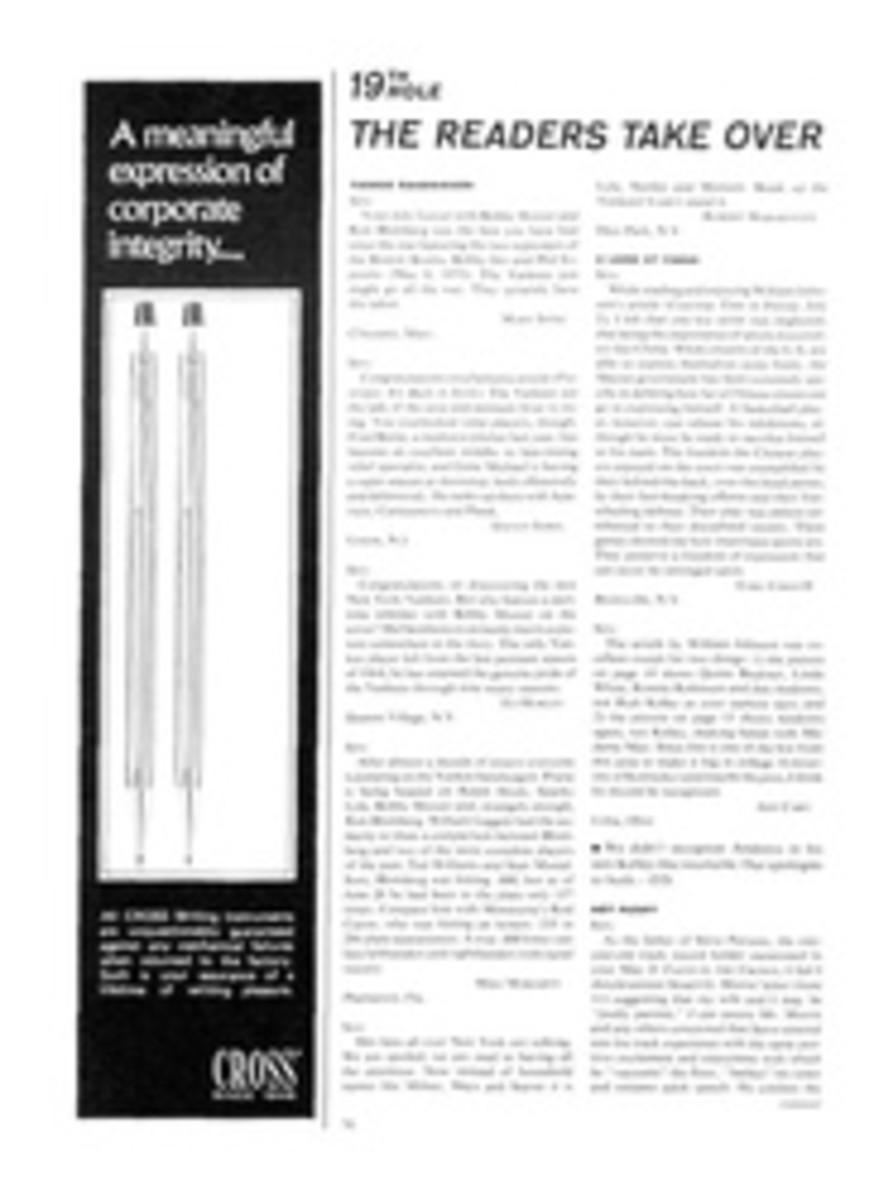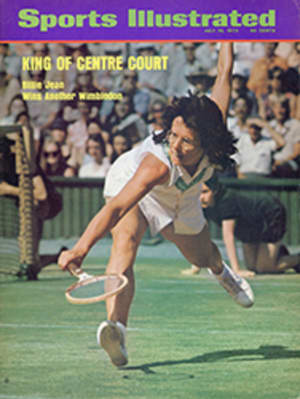
Her turn at a record
Now let's see, where do you begin with Kathy Schmidt? She is large (6'1", 168 pounds) but not muscular. She is athletic, but she seeks out the company of people she considers intellectual. She has trained hard for years, often with considerable pain, but hates to lift weights as her coach recommends. She is addicted to chocolate chip cookies, but would like to give the impression that her real indulgence is gin. She has been described by her friends as a passionate person, and by the same friends as cool. She is, in sum, one imposing, personable, 19-year-old enigma about whom everything seems contradictory until she steps out to compete. Then she is, without doubt, the finest woman javelin thrower this country has ever produced.
Yes, the javelin. She throws it, fairly often for an American record. Soon, she hopes, she will break the world record. Though she and her coach Dave Pearson argue over her seemingly less-than-dedicated training habits, there is a determination about her that chills those who throw against her.
The javelin is not the sort of thing one larks about with. Babe Didrikson—sinewy, relentless, tough—threw the javelin and won a gold medal in the 1932 Olympics. She had what the javelin takes, at least as Pearson sees it.
"You come down the runway, which measures about 80 to 100 feet, holding the javelin horizontally in the palm of your right hand about four or five inches from your ear. Between 25 and 40 feet from the foul line, you take your shoulders back and rotate them 90 degrees to the right so that they are parallel to the direction of the throw. While extending your arm backward, you take four cross steps followed by a hop off your left foot. Still in the air, you set up the throw by rotating your right hip 45 degrees back and bending your torso backward to bring your hips and feet ahead of the torso. You come down on your right foot. As soon as your weight travels past your right foot and before your center of gravity shifts to the left leg, you drive off your right foot into the left leg by turning the right heel out and jamming the left foot into the ground. This whips your right hip very quickly to the front again so that your upper body is twisted. Before your weight has entirely traveled over to your left leg, you must have completed your throw, and the sudden thrust is very aggravating to the elbow."
Pearson says only six or eight men ever have mastered the technique, which may or may not be a pointed reference to Kathy, who has shared an admire-ignore relationship with her coach almost since they first met four years ago. But if Kathy has not perfected her throw, she has done more with it than all but one woman. Babe Didrikson, for instance, won at Los Angeles with a toss of 143'4". Kathy raised the American mark to 200'6" last year, then to 205'6" and 207'10" and finally to 208'1", a mark topped only by Ruth Fuchs" world record of 213'5". Kathy will meet Fuchs, an East German, at the World University Games in Moscow next month, and it is her ambition not only to win there but to set a world record. She has long believed that she has to set it before she turns 20—next Dec. 29.
Such an idea did not come from the Schmidt family; none of them are particularly sports minded, although her father, the president of a Century City insurance company, noted that even as a little girl his daughter seemed to have an unusual athletic aptitude. He had visions of raising a top-seeded tennis player or a golfer. Kathy did become a good tennis player, but Softball was her game. One day a coach at a Long Beach ball park told her, "You have a strong arm. You could become a javelin thrower." Whereupon Kathy asked for a javelin for Christmas. "A what?" said Mrs. Schmidt, but she complied and Kathy was launched, so to speak. Armed with her spear she joined a Long Beach track club, the Comets, and thus began the learning process.
"Javelin throwing is not at all like ball throwing," she says. "You can't do it on a strong arm alone. You have to develop muscles and learn the technique, and that takes years." Still, she went to the national championships that first year (1968), won the girls' division for 14-to 17-year-olds and placed fifth in the women's competition.
At the time, Pearson was a sprint coach with the Comets, but he was the only one around who knew anything about the javelin. He learned in high school after spending all of his savings on a javelin, a discus and a shot, none of which was going to do him much good in his specialty, middle-distance running. He read books and viewed slow-motion film loops and though he never managed to toss any of his new paraphernalia very far he became a student of techniques. For two years he worked out every Sunday with Frank Covelli, the former U.S. record holder in the javelin and most likely the best technician in the country.
Early in 1970, when Kathy was barely 16, she threw 191'6" at a UCLA men's meet. Not long afterward at the Claremont Relays she decided it was time to go after the world record of six years standing, 204'8". "I wanted it like nothing else," she says. "I wanted to kill the javelin." She warmed up with a toss of 206 feet. Then, in an all-out effort during the competition, it happened: halfway through the throw her arm snapped. She heard it snap. It remained stuck at an angle. She had torn the tendon off the bone at the elbow, and doctors told her she would do well to forget the javelin. "They said, 'If you throw again you'll have to throw with pain,' " recalls Kathy. "I figured that. I don't even consider it pain. It's just what I have always had: a sore elbow."
Kathy's case was complicated by the fact that she had not stopped growing when her elbow came unhinged. The doctors ordered complete rest for her arm until she reached full growth and a new attachment to the bone had formed. "That took two dull years," says Kathy.
When she came back last year she treated the elbow gingerly, until Pearson goaded her into trying harder. There were words—there always have been words—but the two remain friends, probably for no other reason than that they both feel someday soon Kathy will become the best woman javelin thrower in history. She has the size and the competitive presence, something that was very evident during the Olympic javelin preliminaries last year at Munich. While others heaved and sighed and warmed down and warmed up between throws, Kathy strolled slowly over to a steeplechase hurdle, sat down on it and ate from a box of Rice Krispies.
"Some people criticize me for being so cash [for casual]," says Kathy, "but I perform best when I'm calm. I wasn't doing my jumping jacks, but three of the top contenders who were didn't make the finals." Kathy did, coming in third to Fuchs and another East German, Jacqueline Todten. Her bronze medal represented exactly half of the total of individual medals won by U.S. women in track and field (the other, a bronze by Kathy Hammond in the 300 meters).
Off the field Kathy Schmidt is as confident as she is on it. She revels in her height and dominates almost everybody around her. "She is very headstrong," says her mother. "Very determined. We fought many battles."
Last December, with her parents' blessings, Kathy moved out of the family home and took an apartment nearby with a girl friend. She is a student at Long Beach City (Junior) College, where she expects to graduate as a communications or media major and eventually become an announcer.
Meanwhile, Kathy is working this summer for Pearson, who has a successful landscaping business. She rises at five every morning to water the lawn at a private club and perform other chores, and practices every afternoon. Recently she hit 228 feet during a workout, but Pearson expects much more. "She has the potential to reach 250 feet," he says, "probably between the ages of 22 and 26, when she will be at her strongest." Which is a long vote of confidence for the feminine physique.
PHOTO

